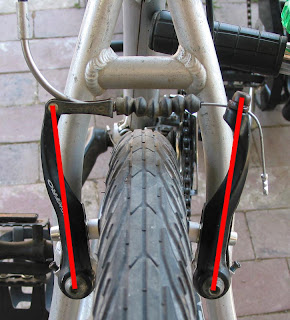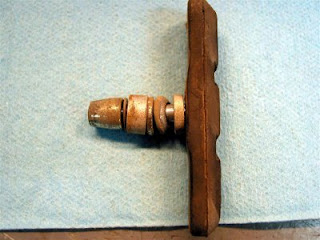By blackmountaincycles,
Filed under: Working on bikes
On the flip-side of less is more, sometimes more is more…better. I’ve also had several bikes in for tune-ups this week that have, well, weak feeling v-brakes. Everything seems right. Spring tension is good. The cable goes through the housing fairly friction-free. But the brakes feel like poo when squeezing the lever. In a case like this, the first thing I do is check the orientation of the spacers on the brake pads. If the thin spacer is on the inside and the top of the arms are getting close to touching, chances are the arms are over-rotating. A v-brake gets its power as the arms close and become parallel. If the arms close to much with the tops closer than the bottom – icky feeling and lost power. This bike came in with not much brake pad left and the thin washer on the inside. New pads and correct pad orientation and it’s like a brand new brake.

The bike above probably has the arms a little too wide at the top, but it’s better than too narrow. In this bike’s case the reason why the tops are a wee bit wide is because it has “S” bend seat stays. The brake boss is positioned at the narrowest part of the seat stay and the spacing between the bosses is just a little bit too narrow. Sure “S” bend stays look cool, but they tend to position the bosses a little on the narrow side. Exact spacing is also a function of rim width, but most frame designers probably just ball-park the dimension (I do) so brakes will work with a variety of rim widths (hooray for disc brakes !?!).
Anywhoo….lighten up on the spring tension!
(What’s playing: The Blasters Border Radio)

The bit about spring tension is sooo true! I cry a little when I come across a brake caliper with excessive return-spring tension; worse; no return-spring tension adjustment at all-I'm looking at you non-Avid mechanical disk brake makers!